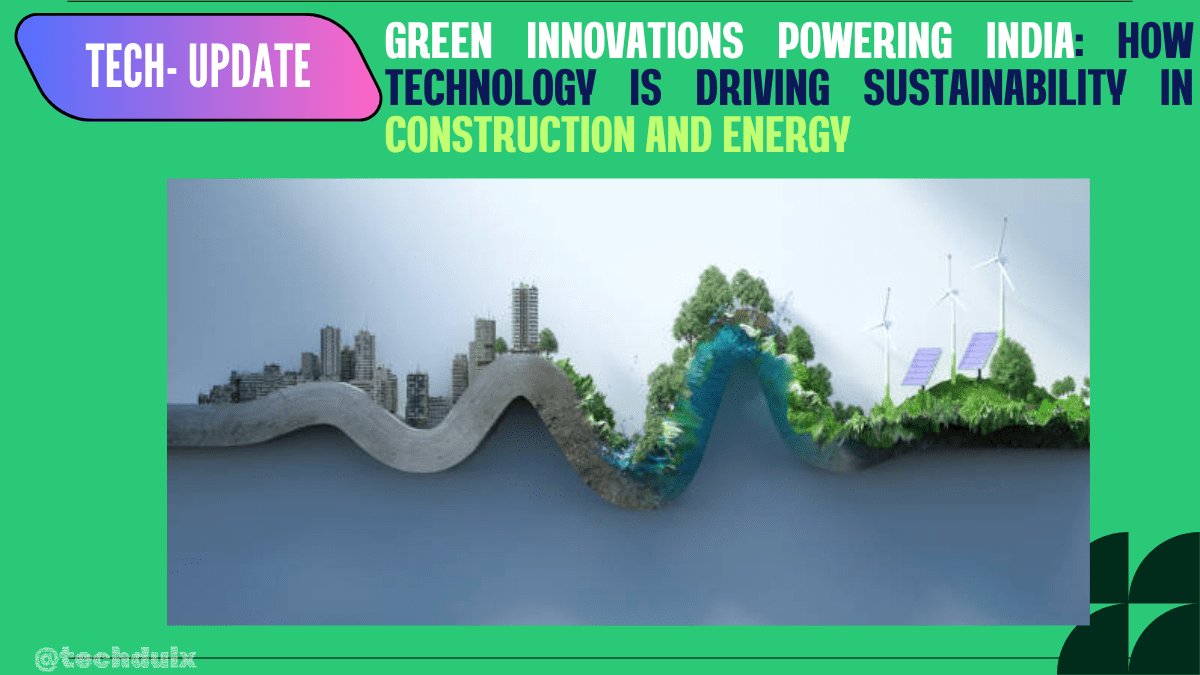Highlights: Green Innovations
- Low-Carbon Concrete: Self-healing concrete, hempcrete, and Ferrock are cutting construction emissions.
- Green Hydrogen Growth: India targets 5 MMT of green hydrogen by 2030 to reduce fossil fuel dependence.
- Energy Efficiency Boost: Smart grids, AI systems, and renewable energy adoption are changing the energy landscape.
- Government Support: National Green Hydrogen Mission and green building incentives are fast-tracking progress.
Introduction: A Greener India Through Technology
As the world races to cut carbon emissions, India is taking bold steps toward a more sustainable future. With its fast-growing economy and clear climate goals, India is turning to technology-driven solutions in both construction and energy. These green innovations are not only reducing the country’s environmental footprint but also setting the stage for long-term growth and resilience.
Building Greener: Sustainable Construction Materials Changing the Game
Traditional construction is one of the largest sources of carbon emissions globally. But that’s changing, thanks to new construction technologies and low-carbon materials now being adopted across India.
1. Low-Carbon Concrete Replacing Traditional Cement
Cement is a huge source of CO₂, but new materials are offering smarter alternatives:
- Ferrock: Made from recycled steel dust and silica, this material not only matches traditional concrete in strength but also absorbs carbon during curing.
- Low-Clinker Concrete: Reduces the use of clinker, the most carbon-intensive part of cement, helping lower emissions.
2. Bio-Based Building Materials
Natural alternatives are taking center stage:
- Hempcrete: A mix of hemp fibers, lime, and water, hempcrete is carbon-negative, absorbing CO₂ as it sets.
- Mycelium Composites: Made from mushroom roots, these fire-resistant panels are lightweight and sustainable, using agricultural waste.
3. Smart and Self-Healing Materials
Tomorrow’s buildings are smart from the inside out:
- Self-Healing Concrete: Automatically fills in cracks, extending the life of infrastructure and reducing maintenance.
- Electrochromic Glass: Changes transparency based on light, helping reduce energy use for heating and cooling.
4. Modular Construction and Circular Economy
- Modular Building: Off-site construction reduces material waste and speeds up timelines.
- Recycled Materials: India is pushing for a circular economy where materials from demolished buildings are reused or repurposed.
India’s Department of Science and Technology is leading by example with five Carbon Capture and Utilisation (CCU) testbeds in the cement sector. These facilities aim to capture CO₂ and convert it into eco-friendly products like lightweight concrete blocks.
Powering the Future: Green Hydrogen and Smarter Energy Use
India’s energy transformation is driven by clean technologies and a strong commitment to energy independence and climate goals.
1. Green Hydrogen: Fuel of the Future
Green hydrogen is produced by splitting water using renewable electricity — with zero carbon emissions.
- Under the National Green Hydrogen Mission, India plans to produce 5 million metric tonnes (MMT) per year by 2030.
- The government offers incentives, tax breaks, and no environmental clearance requirement for green hydrogen and ammonia plants.
- Pilot projects are already live in steel, transportation, and shipping sectors.
2. Smarter Grids, Smarter Energy Use
Generating clean power is just the start — managing it efficiently is the next big step.
a) Renewable Energy Expansion
- In FY 2024-2025, India added 29.52 GW of renewable energy, mostly from solar power.
- Smart grids use real-time data and AI to balance demand and supply, ensuring consistent power and reducing energy loss.
b) AI and IoT in Energy Management
- Buildings and industries are adopting AI-powered energy monitoring, from smart lighting to automated temperature control.
- Predictive maintenance tools help cut waste and improve energy efficiency.
c) Rooftop Solar and Consumer Initiatives
- Programs like the PM Surya Ghar Muft Bijli Yojana help households install solar panels, turning users into prosumers (producers + consumers).
- The BEE Star Rating System helps consumers choose more energy-efficient appliances.
Conclusion: India’s Road to a Smart and Sustainable Future
India’s sustainable growth is being powered by a blend of cutting-edge technology, forward-looking policies, and growing public awareness. From green buildings to clean energy systems, every step is a move toward a greener, more resilient future.
As these green innovations become more widespread and cost-effective, India is not just catching up — it’s leading the way. The future is green, smart, and built on the foundation of technology.
